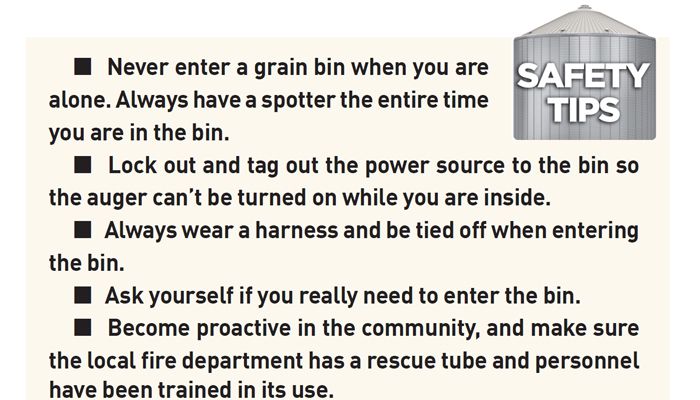Grain bin safety
Author
Published
4/8/2024
Hancock and Winnebago County Farm Bureaus host safety demonstration to train first responders on using rescue tubes to save lives in grain entrapment cases
Confined spaces farm accidents are rare but often can be deadly, making it critical that emergency personnel and the agricultural community train properly for farm duties that may take them into a grain bin or manure pit.
While tractors are still the number one cause of injuries and fatalities on U.S. farms via rollovers, runovers or incidents on rural roadways, confined spaces, incidents with animals or accidents with farm chemicals are among the other common dangers on the farm.
The Hancock and Winnebago County Farm Bureaus jointly sponsored a grain bin safety class and demonstration March 27 for approximately 70 firefighters, Farm Bureau members and local cooperative members, with the goal of providing more farm safety guidance for workers and emergency personnel involving grain bins.
Winnebago County Farm Bureau Vice President Jacob West said the training allowed emergency personnel and others to learn about grain bins and farm equipment, gaining a better understanding of how fast things can go wrong and the proper way to react to a situation.
“It’s important for us to offer these trainings for members, local fire departments and local elevators to increase awareness of grain bin safety,” West said. “It also allows us to better educate people who may not work around farm equipment or bins every day.”
Infrequent but dangerous
Jerry Eslick, instructor with Professional Rescue Innovations (PRI) of Adel, a firm that trains firefighters, industrial workers and emergency personnel in rescue operations, led the training in Forest City. He shared that the U.S. averages 20 grain bin fatalities a year, with 70% of grain entrapments occurring on the farm.
Upwards of 63% of known entrapments involve corn in a steel bin but also can routinely include soybeans, wheat, oats or processed feed and rice.
Indiana and Iowa reported the most incidents over the years dating back to 1964, followed by Minnesota and Illinois.
According to Purdue University Extension, there were at least 42 grain-related entrapments nationwide in 2022, a 44.8% increase over 2021. It was the highest number of grain entrapments in more than a decade.
Iowa reported the most grain entrapment cases in 2022 with nine.
“It’s very important to have first responders ready for these types of incidents,” Eslick said, whose motto is to ‘Prepare for the Worst, Train to be the Best.’ “I would hope through these trainings also that farmers and grain workers are applying more safety to the ag business. If we save one life, it is well worth it.”
What makes grain bin situations difficult aren’t necessarily the bins themselves, Eslick said, but what happens to the grain that’s stored when it gets out of condition, mostly caused by moisture.
“The moisture can make the grain rot, which can cause many problems that include toxic atmospheres, crusted grain or grain that plugs augers and does not allow grain to flow,” he said. “Because of this, the farmer has to get in the bin to solve the problem and can be overcome or entrapped in grain.”

Pictured above: A demonstration participant uses an auger to remove grain after the rescue tubes are put in place to free an individual from entrapment. PHOTO / BOB BJOIN
Rescue tube extraction
Dan Neenan, director of The National Education Center for Agricultural Safety (NECAS) in Calmar, said grain bin safety is a low frequency, high risk situation. Farmers don’t go into the bins daily, but when they do the dangers are ever present.
NECAS, a nonprofit organization, offers similar safety and health programs for farmers, ranchers and agribusiness, as well as ag rescue programs for rural fire and EMS departments.
Training participants in Forest City had the unique opportunity to work together freeing a trapped colleague from a mobile grain bin rescue simulator provided by PRI utilizing the rescue tube concept.
NECAS has similar simulators it takes across the country providing safety and rescue training for freeing trapped individuals.
“The rescue tubes are built around the victim and pushed down around the victim to provide a cofferdam to keep the grain away … Grain is then scooped or augered out until the victim is able to become free on their own,” Neenan said.
“To date, the training that NECAS developed is responsible for 39 grain bin saves from the fire departments we have trained. Since 2014, the program has trained more than 330 departments nationally, and this summer we plan on delivering 65 more.”
Rescue tubes are donated through NECAS’ partnership with Nationwide Insurance and its “Nominate Your Fire Department” contest, held in conjunction with Grain Bin Safety Week during the year.
Neenan said agriculture is considered one of the most dangerous industries in the country, as there are many ways a farmer or worker can be injured or killed while on the job. Proper training provided by NECAS and PRI are crucial for farm safety, he said.
“Long hours and dangerous equipment can lead to a life-changing incident,” Neenan said. “It is important to remember our kids and keeping them safe while living and playing around the farm as well.”
Neenan offered grain bin safety tips, including never entering a bin alone and wearing a harness.
“I believe the event went very well,” said West. “Everyone thanked us for helping them learn the proper way to react and handle a grain entrapment/engulfment.”
The Winnebago and Hancock County Farm Bureaus plan to team up for additional training events later this year, including how to react to emergencies and treat injuries on the farm such as being caught in a bean reel or auger.

Want more news on this topic? Farm Bureau members may subscribe for a free email news service, featuring the farm and rural topics that interest them most!